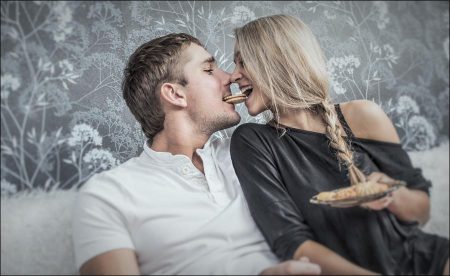Why do couples kiss? In Western cultures, we mark the beginning of romantic entanglement by touching lips. Few actions are as fraught with anxiety and symbolism as that first kiss—and it’s no exaggeration to say that some kisses feel like life or death.
Indeed, a kiss can kill, in the most medical, un-romantic, non-metaphorical sense. Sticking your tongue in the mouth of another person for ten seconds can transmit 80 million bacteria, says one 2014 study. As if to drive this point home, last week the Brazilian government warned pregnant women to refrain from kissing for fear of passing the Zika virus.
But romantic kissing isn’t universal, not even close. In fact, many cultures consider kissing on the lips to be repulsive—a perfectly sound conclusion, given how much disease can pass between mouths. The most authoritative cross-cultural analysis of kissing, published last year in the journal American Anthropologist, reviewed studies of 168 societies and found that less than half showed evidence of “sexual-romantic kissing,” as the authors call it.
Who are the kissing cultures? According to the meta-analysis, couples in economically developed and socially stratified cultures are almost three times more likely to kiss on the lips than those who live in tribes—who are almost four times more likely to never kiss on the lips than counterparts in complex societies. So, lovers in sub-Saharan tribes tend not to kiss, at least in front of European ethnographers, but sophisticated Chilangos and New Yorkers and Muscovites seem to love a good smooch, in private and in public.
What’s up with that? We can’t say for sure, but the cross-disciplinary evidence to date suggests the rise of romantic kissing is linked to the changing roles of women. Studies show, pretty conclusively, that kissing is critical to how modern women choose a sexual partner.
“Women—in the West anyway—have gained far more autonomy in mate choice, and they are freer to kiss and kiss whom they will,” says Sarah Blaffer Hrdy, a famed anthropologist and author of the 1999 bestseller Mother Nature. “Hard to say, though, what women in other cultures would wish to do, if they dared?”
That’s a question some researchers are now tackling—including through a survey of Muslim-majority societies, many of which are in the midst of a transition from arranged to love-based marriages. The results point to a conclusion that studies confirm again and again: Kissing is much more important to women than men—and it’s women who appear to have driven the rise of kissing in romantic life.
Why do we kiss?
Everyone knows the first kiss can launch a thousand ships—or sink every single one of them. “There was one guy I dated who seemed so great,” says Veronica (not her real name), a 40-something single woman in Berkeley, California. “But when we finally kissed, it was like kissing my brother.”
How could Veronica know enough from that one kiss to give up on a relationship that could have lasted a lifetime? When people push their lips together, they appear to exchange an enormous amount of biological information—and research says there is a very good chance that women are covertly picking up pheromones and genetic information that might inform their decision.
In a landmark 2000 study, for example, Claus Wedekind of the University of Lausanne in Switzerland found that women prefer the scents of men whose MHC (major histocompatibility complex) genes are different from their own—which would produce offspring with stronger immune systems. From this perspective, kissing is just sniffing in disguise.
That’s not all that’s happening. According to a 2014 paper, as people kiss on the lips their brain activity spikes and harmonizes. In fact, the degree of synchronization between canoodling brains correlates with the self-reported quality of the kiss.
“If I would speculate about the role of kissing in human life,” says Viktor Müller, the study’s co-author, “I would suggest that kissing synchronizes our brains to produce a state or conditions for a better understanding of each other—or for getting in the right mood for partner-oriented behavior.”
As Veronica discovered, sometimes these brainwaves and olfactory signals combine to say, “Stop!”—and other times they scream “GO!” Even societies that don’t encourage mouth-to-mouth kissing often provide for some kind of up-close snuffling. “Nearly all cultures practice a courtship behavior analogous to kissing, which involves close face-to-face proximity and may involve licking, biting, rubbing, or merely sniffing,” points out Rafael Wlodarski, a University of Oxford post-doctoral researcher who studies mating behavior. The ubiquity of romantic sniffing suggests that it has some evolutionary function. But science hasn’t yet determined exactly what that function is, and this is especially mysterious when sniffing escalates to kissing.
For decades, researchers assumed that evolution hard-wired human lovers to kiss on the lips. In the 1960s, British zoologist Desmond Morris suggested that kissing might have arisen from the primate practice of a mother chewing food and then pushing it with her tongue into the mouth of an infant. Others have suggested that the template for the lover’s kiss is a baby’s mouth on a mother’s breast.
But if that were the case, why don’t friends in France brush each other’s nipples in greeting, instead of grazing each other’s cheeks with their lips? There are plenty of ways for courting lovers to synchronize brain activity and collect subterranean genetic information. Dogs sniff each other’s butts; why can’t we?
If all that sounds gross to you, remember that more than 80 percent of hunter-gatherers think it’s disgusting for two humans to shove their heads together and start licking the inside of each other’s oral cavities. Given that humans have spent most of our history in such groups, it’s more logical to see them as normal and the rest of us as the sexual deviants. Last year’s study of 168 societies overturned decades of scientific speculation by discovering that there is nothing natural or inevitable about kissing on the lips. It’s a learned behavior, and one that appears to emerge only in specific social conditions.
What are those conditions? That’s a matter of debate—but much of the evidence so far suggests that it might be women who turned kissing from a disgusting practice to a desirable one. There’s little question, at this point, that kissing is more important to women than to men in assessing the suitability of a romantic partner.
For example, one 2007 study of 1,041 heterosexual co-eds found “that females place more importance on kissing as a mate assessment device.” Another published in 2013 got a very similar result—a survey of 308 men and 594 women found that, just like Veronica, women often made a snap judgment about the relationship based on the quality of the first kiss. (There are no similar studies of same-sex couples kissing.)
A 2014 study ran two experiments to find out how important a kiss was to deciding whether to move ahead with a partner. The conclusion? The positive impact of purported “kissing quality” on a participant’s willingness to have casual sex with a potential partner was significantly greater for women than it was for men, suggesting that women may be particularly influenced by this factor. When examined in light of previous findings that women are the more selective sex during the mate assessment process, and are particularly attuned to, and discriminating about, cues signaling superior genetic fitness, this result is highly suggestive of the conclusion that kissing may convey some mate quality information.
“If kissing is used in mate assessment, then it is not surprising that females place more value on it,” says Wlodarski, the paper’s lead author. “Since the negative consequences of making a ‘poor’ mating decision are more severe for the female, females are typically more selective and utilize more cues to make mate choice decisions—including potentially kissing.”
Read more articles on Dating and Romance.
Views: 430





